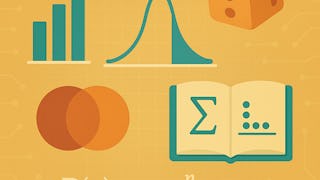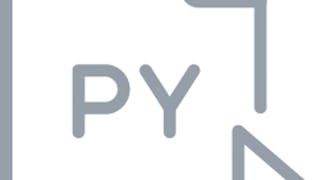This is the fourth of eight courses in the Google Advanced Data Analytics Certificate. In this course, you’ll discover how data professionals use statistics to analyze data and gain important insights. You'll explore key concepts such as descriptive and inferential statistics, probability, sampling, confidence intervals, and hypothesis testing. You'll also learn how to use Python for statistical analysis and practice communicating your findings like a data professional.


The Power of Statistics
This course is part of Google Advanced Data Analytics Professional Certificate

Instructor: Google Career Certificates
83,202 already enrolled
Included with
(860 reviews)
What you'll learn
Explore and summarize a dataset
Use probability distributions to model data
Conduct a hypothesis test to identify insights about data
Perform statistical analyses using Python
Skills you'll gain
Details to know

Add to your LinkedIn profile
27 assignments
See how employees at top companies are mastering in-demand skills

Build your Probability and Statistics expertise
- Learn new concepts from industry experts
- Gain a foundational understanding of a subject or tool
- Develop job-relevant skills with hands-on projects
- Earn a shareable career certificate from Google

There are 6 modules in this course
You’ll explore the role of statistics in data science and identify the difference between descriptive and inferential statistics. You’ll learn how descriptive statistics can help you quickly summarize a dataset and measure the center, spread, and relative position of data.
What's included
12 videos6 readings4 assignments3 ungraded labs2 plugins
You’ll learn the basic rules for calculating probability for single events. Next, you’ll discover how data professionals use methods such as Bayes’ theorem to describe more complex events. Finally, you’ll learn how probability distributions such as the binomial, Poisson, and normal distribution can help you better understand the structure of data.
What's included
14 videos7 readings6 assignments3 ungraded labs4 plugins
Data professionals use smaller samples of data to draw conclusions about large datasets. You’ll learn about the different methods they use to collect and analyze sample data and how they avoid sampling bias. You’ll also learn how sampling distributions can help you make accurate estimates.
What's included
11 videos7 readings4 assignments3 ungraded labs2 plugins
You’ll explore how data professionals use confidence intervals to describe the uncertainty of their estimates. You'll learn how to construct and interpret confidence intervals, and how to avoid some common misinterpretations.
What's included
7 videos3 readings4 assignments3 ungraded labs
Hypothesis testing helps data professionals determine if the results of a test or experiment are statistically significant or due to chance. You’ll learn about the basic steps for any hypothesis test and how hypothesis testing can help you draw meaningful conclusions about data.
What's included
8 videos8 readings5 assignments3 ungraded labs
In this end-of-course project, you’ll use statistical methods such as hypothesis testing to analyze a workplace scenario dataset.
What's included
5 videos10 readings4 assignments6 ungraded labs
Earn a career certificate
Add this credential to your LinkedIn profile, resume, or CV. Share it on social media and in your performance review.
Instructor

Offered by
Explore more from Probability and Statistics
 Status: Free Trial
Status: Free Trial Status: Free Trial
Status: Free TrialBirla Institute of Technology & Science, Pilani
 Status: Free Trial
Status: Free TrialGoogle
 Status: Free Trial
Status: Free Trial
Why people choose Coursera for their career




Learner reviews
860 reviews
- 5 stars
87.32%
- 4 stars
10.11%
- 3 stars
1.51%
- 2 stars
0.58%
- 1 star
0.46%
Showing 3 of 860
Reviewed on Apr 12, 2023
it's very good course ever, and extreme defficult for me as well. thank you Google and Coursera team for producing a good course like this
Reviewed on Sep 19, 2023
Exceptional! I've learned so much about statistics with such a clarity, and how they are being practiced in real life. Thank you, instructor!
Reviewed on Dec 13, 2024
It was quite a technical course and got harder along the way. However the course content made catching up with the technical courses highlighted in this course easier.

Open new doors with Coursera Plus
Unlimited access to 10,000+ world-class courses, hands-on projects, and job-ready certificate programs - all included in your subscription
Advance your career with an online degree
Earn a degree from world-class universities - 100% online
Join over 3,400 global companies that choose Coursera for Business
Upskill your employees to excel in the digital economy
Frequently asked questions
Organizations of all types and sizes have business processes that generate massive volumes of data. Every moment, all sorts of information gets created by computers, the internet, phones, texts, streaming video, photographs, sensors, and much more. In the global digital landscape, data is increasingly imprecise, chaotic, and unstructured. As the speed and variety of data increases exponentially, organizations are struggling to keep pace.
Data science and advanced data analytics are part of a field of study that uses raw data to create new ways of modeling and understanding the unknown. To gain insights, businesses rely on data professionals to acquire, organize, and interpret data, which helps inform internal projects and processes. Data scientists and advanced data analysts rely on a combination of critical skills, including statistics, scientific methods, data analysis, and artificial intelligence.
A data professional is a term used to describe any individual who works with data and/or has data skills. At a minimum, a data professional is capable of exploring, cleaning, selecting, analyzing, and visualizing data. They may also be comfortable with writing code and have some familiarity with the techniques used by statisticians and machine learning engineers, including building models, developing algorithmic thinking, and building machine learning models.
Data professionals are responsible for collecting, analyzing, and interpreting large amounts of data within a variety of different organizations. The role of a data professional is defined differently across companies. Generally speaking, data professionals possess technical and strategic capabilities that require more advanced analytical skills such as data manipulation, experimental design, predictive modeling, and machine learning. They perform a variety of tasks related to gathering, structuring, interpreting, monitoring, and reporting data in accessible formats, enabling stakeholders to understand and use data effectively. Ultimately, the work of data professionals helps organizations make informed, ethical decisions.
Large volumes of data — and the technology needed to manage and analyze it — are becoming increasingly accessible. Because of this, there has been a surge in career opportunities for people who can tell stories using data, such as senior data analysts and data scientists. These professionals collect, analyze, and interpret large amounts of data within a variety of different organizations. Their responsibilities require advanced analytical skills such as data manipulation, experimental design, predictive modeling, and machine learning.
More questions
Financial aid available,

